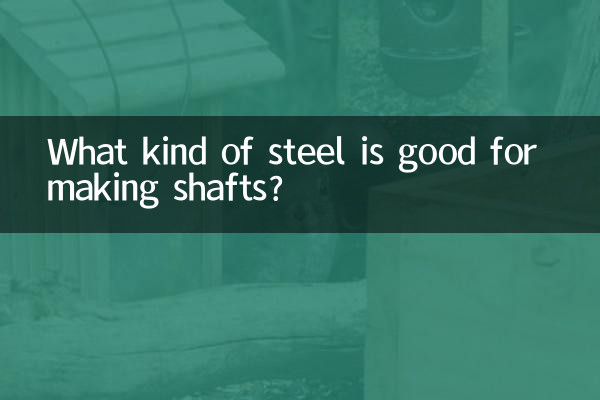What kind of steel is good for making shafts?
In the field of machinery manufacturing, the material selection of shaft parts directly affects their performance and service life. This article will combine the hot topics and hot content on the Internet in the past 10 days to analyze the types of steel commonly used in making shafts and their characteristics to help you make a more reasonable choice.
1. Material requirements for shaft parts

Shaft parts usually need to have the following characteristics:
1. High strength and hardness
2. Good wear resistance
3. Excellent fatigue resistance
4. Appropriate toughness
5. Good processing performance
2. Comparative analysis of commonly used shaft steels
| Steel type | Typical grades | Main features | Applicable scenarios | price range |
|---|---|---|---|---|
| carbon structural steel | 45 steel, Q235 | Low price, good processability, moderate strength | General drive shaft, low load shaft | Low |
| Alloy structural steel | 40Cr, 42CrMo | Good overall performance, high strength, heat treatable | Automobile transmission shaft, machine tool spindle | middle |
| Bearing steel | GCr15, GCr15SiMn | High wear resistance, high contact fatigue strength | Precision bearings, high-precision shafts | higher |
| Stainless steel | 304, 316, 440C | Good corrosion resistance and beautiful appearance | Food machinery, medical equipment | high |
| tool steel | 9SiCr, Cr12MoV | High hardness, excellent wear resistance | Shafts under special working conditions | high |
3. Recent popular steel selection trends
According to the industry discussion hot spots in the past 10 days, the following steel selection trends are worthy of attention:
1.Environmentally friendly steel: As environmental protection requirements increase, steel with low-carbon emission production processes is becoming more popular.
2.High performance alloy steel: In the field of new energy vehicles, the demand for high-strength lightweight alloy steel is growing
3.Customized materials: There is a lot of discussion on shaft material customization solutions under specific working conditions.
4.Surface treatment technology:Basic steel combined with advanced surface treatment has become a new trend
4. Recommendations for specific application scenarios
| Application scenarios | Recommended steel | reason |
|---|---|---|
| Ordinary mechanical transmission shaft | 45 steel, 40Cr | High cost performance, meeting general strength requirements |
| automobile drive shaft | 42CrMo, 20CrMnTi | High fatigue strength, impact resistance |
| Precision instrument shaft | GCr15, 9Cr18 | Good dimensional stability and wear resistance |
| Food machinery shaft | 304 stainless steel | Corrosion-resistant and compliant with hygienic standards |
| Heavy duty mechanical shaft | 35CrMo, 42CrMo | High strength and wear resistance |
5. Things to note when selecting materials
1.cost considerations: Under the premise of meeting performance requirements, try to use lower-priced steel
2.Processing performance: Consider the ease of subsequent heat treatment and machining
3.supply status:Choose steel materials that are easy to purchase on the market
4.standardization: Prioritize the use of standardized steel grades
5.alternative:Learn about interchangeable material options
6. Effect of heat treatment process on shaft performance
The performance of the same steel after different heat treatment processes will be significantly different:
| Heat treatment process | main effect | Applicable steel |
|---|---|---|
| Quenching and tempering treatment | Improve comprehensive mechanical properties | Medium carbon steel, alloy structural steel |
| Quenching + low temperature tempering | Obtain high hardness and wear resistance | Tool steel, bearing steel |
| Carburizing and quenching | The surface is hardened and the core remains tough. | Low carbon alloy steel |
| Nitriding treatment | Improve surface hardness and wear resistance | medium carbon alloy steel |
7. Conclusion
The choice of steel for the shaft requires comprehensive consideration of the use environment, load conditions, accuracy requirements and cost factors. With the development of materials science, new steels and composite materials are constantly emerging. It is recommended to continue to pay attention to industry trends and find the best balance between traditional materials and innovative materials. For key parts of the shaft, it is recommended to consult a professional material engineer for detailed material selection analysis.

check the details

check the details